外文文献最终版
英文文献翻译
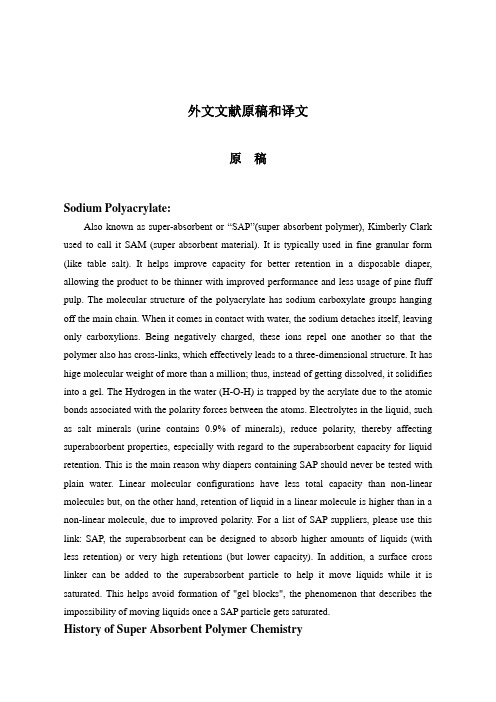
外文文献原稿和译文原稿Sodium Polyacrylate:Also known as super-absorbent or “SAP”(super absorbent polymer), Kimberly Clark used to call it SAM (super absorbent material). It is typically used in fine granular form (like table salt). It helps improve capacity for better retention in a disposable diaper, allowing the product to be thinner with improved performance and less usage of pine fluff pulp. The molecular structure of the polyacrylate has sodium carboxylate groups hanging off the main chain. When it comes in contact with water, the sodium detaches itself, leaving only carboxylions. Being negatively charged, these ions repel one another so that the polymer also has cross-links, which effectively leads to a three-dimensional structure. It has hige molecular weight of more than a million; thus, instead of getting dissolved, it solidifies into a gel. The Hydrogen in the water (H-O-H) is trapped by the acrylate due to the atomic bonds associated with the polarity forces between the atoms. Electrolytes in the liquid, such as salt minerals (urine contains 0.9% of minerals), reduce polarity, thereby affecting superabsorbent properties, especially with regard to the superabsorbent capacity for liquid retention. This is the main reason why diapers containing SAP should never be tested with plain water. Linear molecular configurations have less total capacity than non-linear molecules but, on the other hand, retention of liquid in a linear molecule is higher than in a non-linear molecule, due to improved polarity. For a list of SAP suppliers, please use this link: SAP, the superabsorbent can be designed to absorb higher amounts of liquids (with less retention) or very high retentions (but lower capacity). In addition, a surface cross linker can be added to the superabsorbent particle to help it move liquids while it is saturated. This helps avoid formation of "gel blocks", the phenomenon that describes the impossibility of moving liquids once a SAP particle gets saturated.History of Super Absorbent Polymer ChemistryUn til the 1980’s, water absorbing materials were cellulosic or fiber-based products. Choices were tissue paper, cotton, sponge, and fluff pulp. The water retention capacity of these types of materials is only 20 times their weight – at most.In the early 1960s, the United States Department of Agriculture (USDA) was conducting work on materials to improve water conservation in soils. They developed a resin based on the grafting of acrylonitrile polymer onto the backbone of starch molecules (i.e. starch-grafting). The hydrolyzed product of the hydrolysis of this starch-acrylonitrile co-polymer gave water absorption greater than 400 times its weight. Also, the gel did not release liquid water the way that fiber-based absorbents do.The polymer came to be known as “Super Slurper”.The USDA gave the technical know how several USA companies for further development of the basic technology. A wide range of grating combinations were attempted including work with acrylic acid, acrylamide and polyvinyl alcohol (PVA).Since Japanese companies were excluded by the USDA, they started independent research using starch, carboxy methyl cellulose (CMC), acrylic acid, polyvinyl alcohol (PVA) and isobutylene maleic anhydride (IMA).Early global participants in the development of super absorbent chemistry included Dow Chemical, Hercules, General Mills Chemical, DuPont, National Starch & Chemical, Enka (Akzo), Sanyo Chemical, Sumitomo Chemical, Kao, Nihon Starch and Japan Exlan.In the early 1970s, super absorbent polymer was used commercially for the first time –not for soil amendment applications as originally intended –but for disposable hygienic products. The first product markets were feminine sanitary napkins and adult incontinence products.In 1978, Park Davis (d.b.a. Professional Medical Products) used super absorbent polymers in sanitary napkins.Super absorbent polymer was first used in Europe in a baby diaper in 1982 when Schickendanz and Beghin-Say added the material to the absorbent core. Shortly thereafter, UniCharm introduced super absorbent baby diapers in Japan while Proctor & Gamble and Kimberly-Clark in the USA began to use the material.The development of super absorbent technology and performance has been largely led by demands in the disposable hygiene segment. Strides in absorption performance have allowed the development of the ultra-thin baby diaper which uses a fraction of the materials – particularly fluff pulp – which earlier disposable diapers consumed.Over the years, technology has progressed so that there is little if any starch-grafted super absorbent polymer used in disposable hygienic products. These super absorbents typically are cross-linked acrylic homo-polymers (usually Sodium neutralized).Super absorbents used in soil amendments applications tend to be cross-linked acrylic-acrylamide co-polymers (usually Potassium neutralized).Besides granular super absorbent polymers, ARCO Chemical developed a super absorbent fiber technology in the early 1990s. This technology was eventually sold to Camelot Absorbents. There are super absorbent fibers commercially available today. While significantly more expensive than the granular polymers, the super absorbent fibers offer technical advantages in certain niche markets including cable wrap, medical devices and food packaging.Sodium polyacrylate, also known as waterlock, is a polymer with the chemical formula [-CH2-CH(COONa)-]n widely used in consumer products. It has the ability to absorb as much as 200 to 300 times its mass in water. Acrylate polymers generally are considered to possess an anionic charge. While sodium neutralized polyacrylates are the most common form used in industry, there are also other salts available including potassium, lithium and ammonium.ApplicationsAcrylates and acrylic chemistry have a wide variety of industrial uses that include: ∙Sequestering agents in detergents. (By binding hard water elements such as calcium and magnesium, the surfactants in detergents work more efficiently.) ∙Thickening agents∙Coatings∙Fake snowSuper absorbent polymers. These cross-linked acrylic polymers are referred to as "Super Absorbents" and "Water Crystals", and are used in baby diapers. Copolymerversions are used in agriculture and other specialty absorbent applications. The origins of super absorbent polymer chemistry trace back to the early 1960s when the U.S. Department of Agriculture developed the first super absorbent polymer materials. This chemical is featured in the Maximum Absorbency Garment used by NASA.译文聚丙烯酸钠聚丙烯酸钠,又可以称为超级吸收剂或者又叫高吸水性树脂,凯博利克拉克教授曾经称它为SAM即:超级吸收性物质。
家园共育重要性外文参考文献

家园共育重要性外文参考文献家园共育方法和内容上是有所不同的,但它们的教育对象是一致的,在教育目标上是统一的,最终目的是促使幼儿全面、和谐的发展。
教育目标的共同性决定了两者必须相互合作、紧密配合。
只有家庭和幼儿园保持一致的教育目标,在教育方式上相互合作,才能获得理想的教育效果,反之,孩子就会无所适从,从而导致教育作用的相互抵消甚至起到反作用。
可实际生活中,有一部分家长在家园共育方面存在着一定的困惑和误区,导致了不良的教育效果。
那么,作为家长应如何配合幼儿园做好家园共育工作呢?针对这一问题,我谈几点粗浅的认识:第一、家长要不断学习育儿知识,掌握一些科学的育儿方法。
建议家长朋友们在工作之余牺牲一点娱乐、聚会时间,一是学学一些幼教文章,了解一些新的幼教理念,了解现在的社会需要什么样的人才,自己怎样做才和老师配合好,共同教育好孩子。
二是通过阅读刊物或网上的家教文章、参加幼儿园的家长学校专题讲座,学习幼儿园发放的家长学习材料,与同事朋友交流一下育儿心得等等方式,来学习一些家教知识,提高自身的育儿素质。
第二、家长要通过孩子的表征和讲述了解幼儿园的情况。
家长要不断询问并倾听孩子讲述他一天在幼儿园里看见、听见和所做的事情,欣赏孩子在幼儿园学的歌曲、故事、舞蹈以及手工、图画作品等。
孩子在描述和表征时,可能不是那么完整,但家长一定要耐着性子倾听并鼓励孩子表达完,否则会扼杀孩子的表达欲。
有些孩子在家里喜欢模仿老师,让其他家人来当小朋友做操、做游戏等,这时家长一定要配合孩子,满足他的这种表现欲,这样一是能培养孩子的表达能力和模仿能力,二是家长也能从中来了解幼儿园的情况和孩子的幼儿园生活。
第三、家长要积极参加幼儿园组织的一些活动。
只要时间允许家长朋友们就要按时参加幼儿园组织的一些活动,比如:节日联欢、运动会、家长会、开放活动、亲子活动等,这样家长们能亲自参与到幼儿活动中,以此来了解幼儿园的性质、课程设置、目标等。
并可以全面直观地了解孩子在幼儿园的学习、生活、游戏及与其他小朋友的交往情况,同时也培养了亲子情感。
电力系统毕业论文中英文外文文献翻译精选全文完整版

可编辑修改精选全文完整版电力系统电力系统介绍随着电力工业的增加,与用于生成和处置现今大规模电能消费的电力生产、传输、分派系统相关的经济、工程问题也随之增多。
这些系统组成了一个完整的电力系统。
应该着重提到的是生成电能的工业,它不同凡响的地方在于其产品应按顾客要求即需即用。
生成电的能源以煤、石油,或水库和湖泊中水的形式贮存起来,以备以后所有需。
但这并非会降低用户对发电机容量的需求。
显然,对电力系统而言服务的持续性相当重要。
没有哪一种服务能完全幸免可能显现的失误,而系统的本钱明显依托于其稳固性。
因此,必需在稳固性与本钱之间找到平稳点,而最终的选择应是负载大小、特点、可能显现中断的缘故、用户要求等的综合表现。
但是,网络靠得住性的增加是通过应用必然数量的生成单元和在发电站港湾各分区间和在国内、国际电网传输线路中利用自动断路器得以实现的。
事实上大型系统包括众多的发电站和由高容量传输线路连接的负载。
如此,在不中断整体服务的前提下能够停止单个发电单元或一套输电线路的运作。
现此生成和传输电力最普遍的系统是三相系统。
相关于其他交流系统而言,它具有简便、节能的优势。
尤其是在特定导体间电压、传输功率、传输距离和线耗的情形下,三相系统所需铜或铝仅为单相系统的75%。
三相系统另一个重要优势是三相电机比单相电机效率更高。
大规模电力生产的能源有:1.从常规燃料(煤、石油或天然气)、城市废料燃烧或核燃料应用中取得的蒸汽;2.水;3.石油中的柴油动力。
其他可能的能源有太阳能、风能、潮汐能等,但没有一种超越了试点发电站时期。
在大型蒸汽发电站中,蒸汽中的热能通过涡轮轮转换为功。
涡轮必需包括安装在轴承上并封锁于汽缸中的轴或转子。
转子由汽缸周围喷嘴喷射出的蒸汽流带动而平稳地转动。
蒸汽流撞击轴上的叶片。
中央电站采纳冷凝涡轮,即蒸汽在离开涡轮后会通过一冷凝器。
冷凝器通过其导管中大量冷水的循环来达到冷凝的成效,从而提高蒸汽的膨胀率、后继效率及涡轮的输出功率。
(完整word版)机械外文翻译外文文献英文文献一个复杂纸盒的包装机器人
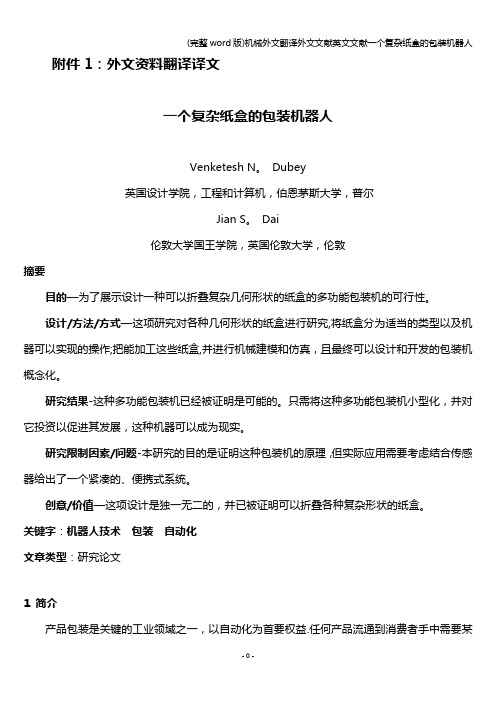
附件1:外文资料翻译译文一个复杂纸盒的包装机器人Venketesh N。
Dubey英国设计学院,工程和计算机,伯恩茅斯大学,普尔Jian S。
Dai伦敦大学国王学院,英国伦敦大学,伦敦摘要目的—为了展示设计一种可以折叠复杂几何形状的纸盒的多功能包装机的可行性。
设计/方法/方式—这项研究对各种几何形状的纸盒进行研究,将纸盒分为适当的类型以及机器可以实现的操作;把能加工这些纸盒,并进行机械建模和仿真,且最终可以设计和开发的包装机概念化。
研究结果-这种多功能包装机已经被证明是可能的。
只需将这种多功能包装机小型化,并对它投资以促进其发展,这种机器可以成为现实。
研究限制因素/问题-本研究的目的是证明这种包装机的原理,但实际应用需要考虑结合传感器给出了一个紧凑的、便携式系统。
创意/价值—这项设计是独一无二的,并已被证明可以折叠各种复杂形状的纸盒。
关键字:机器人技术包装自动化文章类型:研究论文1 简介产品包装是关键的工业领域之一,以自动化为首要权益.任何产品流通到消费者手中需要某种形式的包装,无论是食品、礼品或医疗用品。
因此,对高速的产品包装有持续的需求。
对于周期性消费品和精美礼品,这项需求更是大大增加.它们要求包装设计新颖且有吸引力,以吸引潜在客户。
通常这类产品用外观精美、形状复杂的纸盒递送。
如果采用手工方法进行包装,不仅令工人感到乏味且操作复杂,也费时和单调。
对于简单的纸盒包装,通过使用沿传送带布置的专用机器,已经获得了实现。
这些机器只能处理固定类型的纸盒,任何形状和结构的变化很难纳入到系统之中。
在大多数情况下,它们需要进行超过40种变化以适应同种类型但大小不同的纸盒,这就意味着每一个特定类型的纸盒需要一条包装生产线。
从一种类型到另一种类型的纸盒折叠组装生产线的转换将会使资本支出增加。
因为这些限制因素和转换生产线的相关成本,包装的灵活性将会失去。
因此,作为一种补充,手工生产线被引进以适应不同类型的纸盒的生产,从而解决转换生产线的问题.它们承担了大约10%的工作订单,并被用作生产促销产品的组装生产线.但是,问题仍然存在,手工生产线上的管理员和操作工需要一个长时间的学习过程,而且与机器生产线不同,劳动伤害主要是源于扭手动作.此外,手工生产线通常被认为是一个季节性的生产力,仍然需要专门的机器长年运行,以节约成本和时间。
建筑学Modern-Architecture现代建筑大学毕业论文外文文献翻译及原文
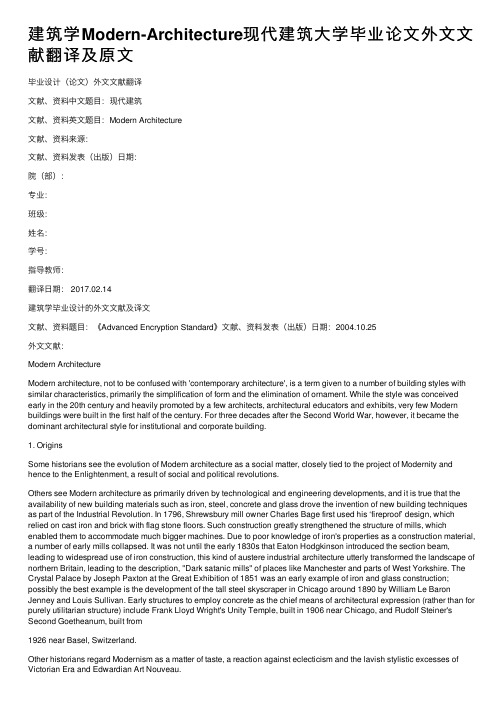
建筑学Modern-Architecture现代建筑⼤学毕业论⽂外⽂⽂献翻译及原⽂毕业设计(论⽂)外⽂⽂献翻译⽂献、资料中⽂题⽬:现代建筑⽂献、资料英⽂题⽬:Modern Architecture⽂献、资料来源:⽂献、资料发表(出版)⽇期:院(部):专业:班级:姓名:学号:指导教师:翻译⽇期: 2017.02.14建筑学毕业设计的外⽂⽂献及译⽂⽂献、资料题⽬:《Advanced Encryption Standard》⽂献、资料发表(出版)⽇期:2004.10.25外⽂⽂献:Modern ArchitectureModern architecture, not to be confused with 'contemporary architecture', is a term given to a number of building styles with similar characteristics, primarily the simplification of form and the elimination of ornament. While the style was conceived early in the 20th century and heavily promoted by a few architects, architectural educators and exhibits, very few Modern buildings were built in the first half of the century. For three decades after the Second World War, however, it became the dominant architectural style for institutional and corporate building.1. OriginsSome historians see the evolution of Modern architecture as a social matter, closely tied to the project of Modernity and hence to the Enlightenment, a result of social and political revolutions.Others see Modern architecture as primarily driven by technological and engineering developments, and it is true that the availability of new building materials such as iron, steel, concrete and glass drove the invention of new building techniques as part of the Industrial Revolution. In 1796, Shrewsbury mill owner Charles Bage first used his ‘fireproof’ design, which relied on cast iron and brick with flag stone floors. Such construction greatly strengthened the structure of mills, which enabled them to accommodate much bigger machines. Due to poor knowledge of iron's properties as a construction material, a number of early mills collapsed. It was not until the early 1830s that Eaton Hodgkinson introduced the section beam, leading to widespread use of iron construction, this kind of austere industrial architecture utterly transformed the landscape of northern Britain, leading to the description, "Dark satanic mills" of places like Manchester and parts of West Yorkshire. The Crystal Palace by Joseph Paxton at the Great Exhibition of 1851 was an early example of iron and glass construction; possibly the best example is the development of the tall steel skyscraper in Chicago around 1890 by William Le Baron Jenney and Louis Sullivan. Early structures to employ concrete as the chief means of architectural expression (rather than for purely utilitarian structure) include Frank Lloyd Wright's Unity Temple, built in 1906 near Chicago, and Rudolf Steiner's Second Goetheanum, built from1926 near Basel, Switzerland.Other historians regard Modernism as a matter of taste, a reaction against eclecticism and the lavish stylistic excesses of Victorian Era and Edwardian Art Nouveau.Whatever the cause, around 1900 a number of architects around the world began developing new architectural solutions to integrate traditional precedents (Gothic, for instance) with new technological possibilities. The work of Louis Sullivan and Frank Lloyd Wright in Chicago, Victor Horta in Brussels, Antoni Gaudi in Barcelona, Otto Wagner in Vienna and Charles Rennie Mackintosh in Glasgow, among many others, can be seen as a common struggle between old and new.2. Modernism as Dominant StyleBy the 1920s the most important figures in Modern architecture had established their reputations. The big three are commonly recognized as Le Corbusier in France, and Ludwig Mies van der Rohe and Walter Gropius in Germany. Mies van der Rohe and Gropius were both directors of the Bauhaus, one of a number of European schools and associations concerned with reconciling craft tradition and industrial technology.Frank Lloyd Wright's career parallels and influences the work of the European modernists, particularly via the Wasmuth Portfolio, but he refused to be categorized with them. Wright was a major influence on both Gropius and van der Rohe, however, as well as on the whole of organic architecture.In 1932 came the important MOMA exhibition, the International Exhibition of Modern Architecture, curated by Philip Johnson. Johnson and collaborator Henry-Russell Hitchcock drew together many distinct threads and trends, identified them as stylistically similar and having a common purpose, and consolidated them into the International Style.This was an important turning point. With World War II the important figures of the Bauhaus fled to the United States, to Chicago, to the Harvard Graduate School of Design, and to Black Mountain College. While Modern architectural design never became a dominant style in single-dwelling residential buildings, in institutional and commercial architecture Modernism became the pre-eminent, and in the schools (for leaders of the profession) the only acceptable, design solution from about 1932 to about 1984.Architects who worked in the international style wanted to break with architectural tradition and design simple, unornamented buildings. The most commonly used materials are glass for the facade, steel for exterior support, and concrete for the floors and interior supports; floor plans were functional and logical. The style became most evident in the design of skyscrapers. Perhaps its most famous manifestations include the United Nations headquarters (Le Corbusier, Oscar Niemeyer, Sir Howard Robertson), the Seagram Building (Ludwig Mies van der Rohe), and Lever House (Skidmore, Owings, and Merrill), all in New York. A prominent residential example is the Lovell House (Richard Neutra) in Los Angeles.Detractors of the international style claim that its stark, uncompromisingly rectangular geometry is dehumanising. Le Corbusier once described buildings as "machines for living", but people are not machines and it was suggested that they do not want to live in machines. Even Philip Johnson admitted he was "bored with the box." Since the early 1980s many architects have deliberately sought to move away from rectilinear designs, towards more eclectic styles. During the middle of the century, some architects began experimenting in organic forms that they felt were more human and accessible. Mid-century modernism, or organic modernism, was very popular, due to its democratic and playful nature. Alvar Aalto and Eero Saarinen were two of the most prolific architects and designers in this movement, which has influenced contemporary modernism.Although there is debate as to when and why the decline of the modern movement occurred, criticism of Modern architecture began in the 1960s on the grounds that it was universal, sterile, elitist and lacked meaning. Its approach had become ossified in a "style" that threatened to degenerate into a set of mannerisms. Siegfried Giedion in the 1961 introduction to his evolving text, Space, Time and Architecture (first written in 1941), could begin "At the moment a certain confusion exists in contemporary architecture, as in painting; a kind of pause, even a kind of exhaustion." At the Metropolitan Museum of Art, a 1961 symposium discussed the question "Modern Architecture: Death or Metamorphosis?" In New York, the coup d'état appeared to materialize in controversy around the Pan Am Building that loomed over Grand Central Station, taking advantage of the modernist real estate concept of "air rights",[1] In criticism by Ada Louise Huxtable and Douglas Haskell it was seen to "sever" the Park Avenue streetscape and "tarnish" the reputations of its consortium of architects: Walter Gropius, Pietro Belluschi and thebuilders Emery Roth & Sons. The rise of postmodernism was attributed to disenchantment with Modern architecture. By the 1980s, postmodern architecture appeared triumphant over modernism, including the temple of the Light of the World, a futuristic design for its time Guadalajara Jalisco La Luz del Mundo Sede International; however, postmodern aesthetics lacked traction and by the mid-1990s, a neo-modern (or hypermodern) architecture had once again established international pre-eminence. As part of this revival, much of the criticism of the modernists has been revisited, refuted, and re-evaluated; and a modernistic idiom once again dominates in institutional and commercial contemporary practice, but must now compete with the revival of traditional architectural design in commercial and institutional architecture; residential design continues to be dominated by a traditional aesthetic.中⽂译⽂:现代建筑现代建筑,不被混淆与'当代建筑' , 是⼀个词给了⼀些建筑风格有类似的特点, 主要的简化形式,消除装饰等. 虽然风格的设想早在20世纪,并⼤量造就了⼀些建筑师、建筑教育家和展品,很少有现代的建筑物,建于20世纪上半叶. 第⼆次⼤战后的三⼗年, 但最终却成为主导建筑风格的机构和公司建设.1起源⼀些历史学家认为进化的现代建筑作为⼀个社会问题, 息息相关的⼯程中的现代性,从⽽影响了启蒙运动,导致社会和政治⾰命.另⼀些⼈认为现代建筑主要是靠技术和⼯程学的发展, 那就是获得新的建筑材料,如钢铁, 混凝⼟和玻璃驱车发明新的建筑技术,它作为⼯业⾰命的⼀部分. 1796年, shrewsbury查尔斯bage⾸先⽤他的'⽕'的设计, 后者则依靠铸铁及砖与⽯材地板. 这些建设⼤⼤加强了结构,使它们能够容纳更⼤的机器. 由于作为建筑材料特性知识缺乏,⼀些早期建筑失败. 直到1830年初,伊顿Hodgkinson预计推出了型钢梁, 导致⼴泛使⽤钢架建设,⼯业结构完全改变了这种窘迫的⾯貌,英国北部领导的描述, "⿊暗魔⿁作坊"的地⽅如曼彻斯特和西约克郡. ⽔晶宫由约瑟夫paxton的重⼤展览, 1851年,是⼀个早期的例⼦,钢铁及玻璃施⼯; 可能是⼀个最好的例⼦,就是1890年由William乐男爵延长和路易沙利⽂在芝加哥附近发展的⾼层钢结构摩天楼. 早期结构采⽤混凝⼟作为⾏政⼿段的建筑表达(⽽⾮纯粹功利结构) ,包括建于1906年在芝加哥附近,劳埃德赖特的统⼀宫, 建于1926年瑞⼠巴塞尔附近的鲁道夫斯坦纳的第⼆哥特堂,.但⽆论原因为何, 约有1900多位建筑师,在世界各地开始制定新的建筑⽅法,将传统的先例(⽐如哥特式)与新的技术相结合的可能性.路易沙利⽂和赖特在芝加哥⼯作,维克多奥尔塔在布鲁塞尔,安东尼⾼迪在巴塞罗那, 奥托⽡格纳和查尔斯景mackintosh格拉斯哥在维也纳,其中之⼀可以看作是⼀个新与旧的共同⽃争.2现代主义风格由1920年代的最重要⼈物,在现代建筑⾥确⽴了⾃⼰的名声. 三个是公认的柯布西耶在法国, 密斯范德尔德罗和⽡尔特格罗⽪乌斯在德国. 密斯范德尔德罗和格罗⽪乌斯为董事的包豪斯, 其中欧洲有不少学校和有关团体学习调和⼯艺和传统⼯业技术.赖特的建筑⽣涯中,也影响了欧洲建筑的现代艺术,特别是通过⽡斯穆特组合但他拒绝被归类与他们. 赖特与格罗⽪乌斯和Van der德罗对整个有机体系有重⼤的影响.在1932年来到的重要moma展览,是现代建筑艺术的国际展览,艺术家菲利普约翰逊. 约翰逊和合作者亨利-罗素阁纠集许多鲜明的线索和趋势, 内容相似,有⼀个共同的⽬的,巩固了他们融⼊国际化风格这是⼀个重要的转折点. 在⼆战的时间包豪斯的代表⼈物逃到美国,芝加哥,到哈佛⼤学设计⿊⼭书院. 当现代建筑设计从未成为主导风格单⼀的住宅楼,在成为现代卓越的体制和商业建筑, 是学校(专业领导)的唯⼀可接受的, 设计解决⽅案,从约1932年⾄约1984年.那些从事国际风格的建筑师想要打破传统建筑和简单的没有装饰的建筑物。
船舶设计论文中英文外文翻译文献

船舶设计论文中英文外文翻译文献XXX shipbuilding。
with a single large container vessel consisting of approximately 1.5 n atomic components in a n hierarchy。
this n is considered a XXX involves a distributed multi-agent n that runs on top of PVM.2 XXXShip XXX process。
as well as the final product's performance and safety。
nal design XXX-consuming and often fail to consider all the complex factors XXX。
there is a need for a more XXX designers.3 The Role of HPCN in Ship Design nHPCN。
or high-performance computing and orking。
has the potential to XXX utilizing the massive parallel processing power of HPCN。
designers XXX changes。
cing the time and cost of thedesign process。
nally。
HPCN can handle the complex XXX。
XXX.4 XXX XXX of the HPCN n Support ToolThe XXX ship designers is implemented as a distributed multi-agent n that runs on top of PVM。
企业管理外文文献及翻译
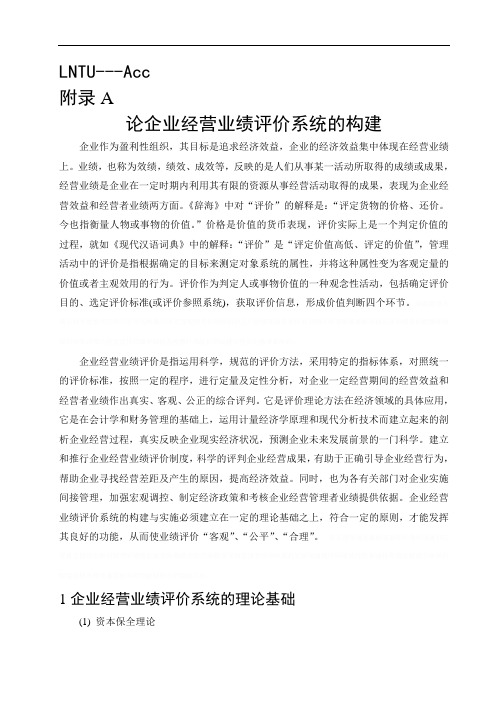
LNTU---Acc附录A论企业经营业绩评价系统的构建企业作为盈利性组织,其目标是追求经济效益,企业的经济效益集中体现在经营业绩上。
业绩,也称为效绩,绩效、成效等,反映的是人们从事某一活动所取得的成绩或成果,经营业绩是企业在一定时期内利用其有限的资源从事经营活动取得的成果,表现为企业经营效益和经营者业绩两方面。
《辞海》中对“评价”的解释是:“评定货物的价格、还价。
今也指衡量人物或事物的价值。
”价格是价值的货币表现,评价实际上是一个判定价值的过程,就如《现代汉语词典》中的解释:“评价”是“评定价值高低、评定的价值”,管理活动中的评价是指根据确定的目标来测定对象系统的属性,并将这种属性变为客观定量的价值或者主观效用的行为。
评价作为判定人或事物价值的一种观念性活动,包括确定评价目的、选定评价标准(或评价参照系统),获取评价信息,形成价值判断四个环节。
企业经营业绩评价是指运用科学,规范的评价方法,采用特定的指标体系,对照统一的评价标准,按照一定的程序,进行定量及定性分析,对企业一定经营期间的经营效益和经营者业绩作出真实、客观、公正的综合评判。
它是评价理论方法在经济领域的具体应用,它是在会计学和财务管理的基础上,运用计量经济学原理和现代分析技术而建立起来的剖析企业经营过程,真实反映企业现实经济状况,预测企业未来发展前景的一门科学。
建立和推行企业经营业绩评价制度,科学的评判企业经营成果,有助于正确引导企业经营行为,帮助企业寻找经营差距及产生的原因,提高经济效益。
同时,也为各有关部门对企业实施间接管理,加强宏观调控、制定经济政策和考核企业经营管理者业绩提供依据。
企业经营业绩评价系统的构建与实施必须建立在一定的理论基础之上,符合一定的原则,才能发挥其良好的功能,从而使业绩评价“客观”、“公平”、“合理”。
1企业经营业绩评价系统的理论基础(1) 资本保全理论在市场经济条件下,企业是出资者的企业,是一个资本集合体,所有者是惟一的剩余风险承担者和剩余权益享受者,出资者利益是企业最高利益。
跨境电商外文文献综述

跨境电商外文文献综述跨境电商外文文献综述跨境电商外文文献综述(文档含英文原文和中文翻译) 译文: 本地化跨境电子商务的模型摘要通过对国际供应链的B2B电子商务交易量的快速增长和伊朗快速增加的跨境交易业务,跨境电商过程的有效管理对B2B电子商务系统十分重要。
对局部模型的结构是基于B2B电子商务的基础设施三大层,消息层、业务流程层和内容层。
于伊朗的电子商务的要求,每一层的需要适当的标准和合适的方案的选择。
当电子文件需要移动顺利向伊朗,建议文件的标准为文件内容支持纸质和电子文件阅读。
验证提出的模型是通过案例研究方法呈现一到四阶段的情景。
试图通过交换商业文件在贸易过程中这一局部模型,实现在全球电子贸易供应链更接近区域单一窗口建设的关键目标。
关键词:电子商务;跨境贸易;电子文档管理;国际供应链跨境电商外文文献综述1。
简介电子商务是关于在互联网或其他网络电子系统购买和销售产品或服务。
术语B2B,描述了企业间的电子商务交易,如制造商和批发商,或批发商和零售商之间。
的研究目标是上两个不同国家贸易商之间的通信。
今天的世界贸易组织的主要目标之一是建立区域单一窗口,可以提高世界各地的贸易便利化。
建立区域单一窗口需要跨境海关,可以有效地交换贸易文件.因此,首先,简化跨境贸易文件的关键在于朝着国家单一窗口移动.然后,区域单一窗口可以授权国家之间的通信。
电子商务模型是基于三个主要逻辑层的研究。
这三个层消息传输层,业务处理层和内容层.的局部模型是一种能够自动交换读取文件的过程.通过与东亚和中东国家的建立区域单一窗口可以在将来得到改善的更多的互操作性,从而建立伊朗国家单一窗口在的第二部分讨论引进国际供应链中的跨境B2B模式所需的基本概念和标准。
第三部分介绍在大的模型中引入的组件功能和范围。
第四部分讨论了B2B交易层模型的定位,最后结束。
2.背景在本节中,除了了解B2B电子商务在伊朗的情况,还有参考模型的背景等概念以及讨论B2B电子商务跨境模式的本土化。
读书报告-外文文献

读书报告——外文文献【1】Guy Parsons, Empowering employees-back to the future at Novotel [J], Managing Service QualityV olume5.Number4-1995.pp.16-21, (泛读)本文以Novotel 为例,通过讲述Novotel 在HRM方面的经验,说明当今社会已经进入体验经济时代,客人需要的是个性化的定制化的服务和体验。
为了满足客人的需求,创造完美的消费经历,酒店应该合理对员工授权;授权不仅仅是提高了顾客的满意度,还提高员工的积极性。
文章中对员工的授权不仅仅是对一线员工的授权,还包括对高级管理层的授权,尤其是酒店的最高管理层。
对于酒店来说,酒店经理更能够准确把握市场,把握将来的走势;对酒店管理层的授权,有利于酒店的创新和酒店的长远发展。
同时文章还指出酒店对员工的授权也存在着风险和困难,尤其是实际的控制非常的困难,这就要求酒店根据自己的经验,并结合科学的原理,来制定具有操作性强的授权方案。
【2】 B.Joseph Pine II & James H.Gilmore,Welcome to the experience economy[J], Harvard Business Review July-August 1998,(精读)本文将人类经济发展分为四个阶段:农业经济、工业经济、服务经济和体验经济。
两位作者通过大量的实例来阐述了体验经济时代的到来,认为体验经济是服务经济的提升和剥离,并阐述了体验经济的特征,从参与性的主动被动程度和关联性的吸引与沉浸程度这两个纬度的,得出了四种极端类型的体验经济产品:即高吸引、积极参与性的如娱乐业,高吸引、被动参与的如教育,高沉浸、积极参与的如审美,高沉浸、被动参与的如逃避现实。
最后文章给出了具有回忆性经历的设计主要原则:一是使体验主题化,二是协调印象和积极暗示,三是消除消极暗示,四是增加纪念物品,五是使“五觉”参与其中。
公司人才流失问题的研究外文参考文献译文与原文
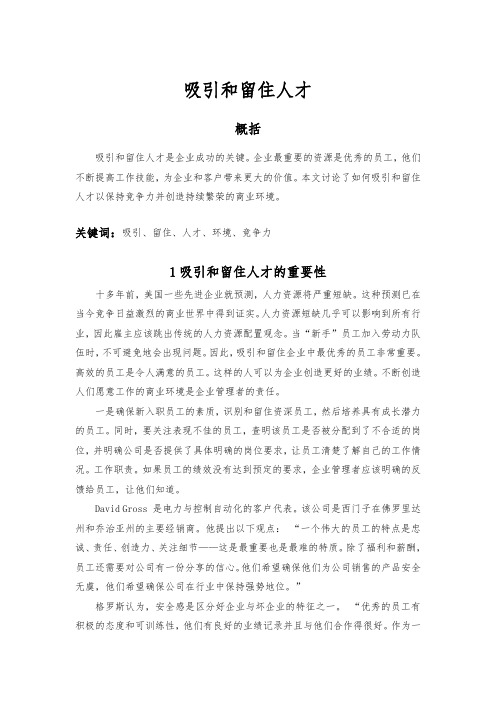
吸引和留住人才概括吸引和留住人才是企业成功的关键。
企业最重要的资源是优秀的员工,他们不断提高工作技能,为企业和客户带来更大的价值。
本文讨论了如何吸引和留住人才以保持竞争力并创造持续繁荣的商业环境。
关键词:吸引、留住、人才、环境、竞争力1吸引和留住人才的重要性十多年前,美国一些先进企业就预测,人力资源将严重短缺。
这种预测已在当今竞争日益激烈的商业世界中得到证实。
人力资源短缺几乎可以影响到所有行业,因此雇主应该跳出传统的人力资源配置观念。
当“新手”员工加入劳动力队伍时,不可避免地会出现问题。
因此,吸引和留住企业中最优秀的员工非常重要。
高效的员工是令人满意的员工。
这样的人可以为企业创造更好的业绩。
不断创造人们愿意工作的商业环境是企业管理者的责任。
一是确保新入职员工的素质,识别和留住资深员工,然后培养具有成长潜力的员工。
同时,要关注表现不佳的员工,查明该员工是否被分配到了不合适的岗位,并明确公司是否提供了具体明确的岗位要求,让员工清楚了解自己的工作情况。
工作职责。
如果员工的绩效没有达到预定的要求,企业管理者应该明确的反馈给员工,让他们知道。
David Gross 是电力与控制自动化的客户代表。
该公司是西门子在佛罗里达州和乔治亚州的主要经销商。
他提出以下观点:“一个伟大的员工的特点是忠诚、责任、创造力、关注细节——这是最重要也是最难的特质。
除了福利和薪酬,员工还需要对公司有一份分享的信心。
他们希望确保他们为公司销售的产品安全无虞,他们希望确保公司在行业中保持强势地位。
”格罗斯认为,安全感是区分好企业与坏企业的特征之一。
“优秀的员工有积极的态度和可训练性,他们有良好的业绩记录并且与他们合作得很好。
作为一家小型企业,我们可以更加灵活,我们很自豪能够为我们的员工提供家庭友好的氛围,更加自主管理的风格。
我们允许员工处理个人事务,但稍后会为该工作腾出时间,而且我们的一揽子福利非常具有竞争力。
”1.1 优秀员工对公司的期望任何行业的任何公司的员工对公司都有以下需求,按重要性和重要性的降序排列。
论文外文文献翻译流程

论文外文文献翻译流程论文外文文献翻译是研究工作中常见的一项任务,其流程可以分为以下几个步骤:1. 选择文献:首先,需要从相关学术期刊、会议论文集或其他学术资源中选择适合自己研究方向的外文文献。
在选择时,要根据研究目的和问题确定文献的质量和可靠性,以确保所选文献具有较高的学术价值。
2. 阅读理解:在开始翻译之前,要对选定的外文文献进行仔细阅读和理解。
这包括理解文献的结构和核心内容,获取对于自己研究的重要信息和观点。
3. 翻译规划:在开始翻译之前,需要制定一个翻译计划。
这包括确定翻译的时间安排、分工和所需的翻译工具,以确保翻译的高效进行。
4. 翻译过程:在翻译过程中,可以采用逐句翻译的方式,将原文逐句翻译成目标语言,注意保持原文的准确性和清晰度。
如果遇到词汇或表达不明确的地方,需要进行相关的查询和澄清。
在翻译过程中,还要注意语法和句子结构的准确性,以确保翻译的流畅度和可读性。
5. 校对修改:在完成翻译后,需要进行校对和修改。
在这个阶段,要比对原文和译文,检查译文的准确性和信息的完整性。
如果发现有任何错误或不完善之处,需要进行相应的修改和调整。
6. 审稿意见:在完成校对修改后,可以邀请一些专业人士或同行进行审稿。
他们可以对翻译的准确性和语言的表达提出宝贵的意见和建议,以进一步提高翻译质量。
7. 格式调整:在翻译完成后,需要对文献进行格式调整。
这包括调整字体、段落、标点和引用等格式,以符合目标语言的学术写作要求。
8. 最终定稿:最后一步是最终定稿,将翻译后的外文文献整理成最终的版本。
在这个阶段,要检查文献的所有细节,确保没有任何错误和遗漏。
整个外文文献翻译流程需要仔细和耐心地进行,以确保翻译的准确性和质量。
熟悉外文学术规范和术语的使用是提高翻译效果的关键。
并且,要合理利用翻译工具和辅助资源,提高翻译的效率和准确性。
最终的翻译成果将为研究工作提供重要的支持和参考。
机械类数控车床外文翻译外文文献英文文献数控

数控加工中心技术开展趋势与对策原文来源:Zhao Chang-ming Liu Wang-ju(C Machining Processand equipment,2002,China)一、摘要Equip the engineering level, level of determining the whole national economy of the modernized degree and modernized degree of industry, numerical control technology is it develop new developing new high-tech industry and most advanced industry to equip (such as information technology and his industry, biotechnology and his industry, aviation, spaceflight, etc. national defense industry) last technology and getting more basic most equipment.Numerical control technology is the technology controlled to mechanical movement and working course with digital information, integrated products of electromechanics that the numerical control equipment is the new technology represented by numerical control technology forms to the manufacture industry of the tradition and infiltration of the new developing manufacturing industry,Keywords:Numerical ControlTechnology, E quipment,industry二、译文数控技术和装备开展趋势与对策装备工业的技术水平和现代化程度决定着整个国民经济的水平和现代化程度,数控技术与装备是开展新兴高新技术产业和尖端工业〔如信息技术与其产业、生物技术与其产业、航空、航天等国防工业产业〕的使能技术和最根本的装备。
建筑施工质量控制外文翻译参考文献
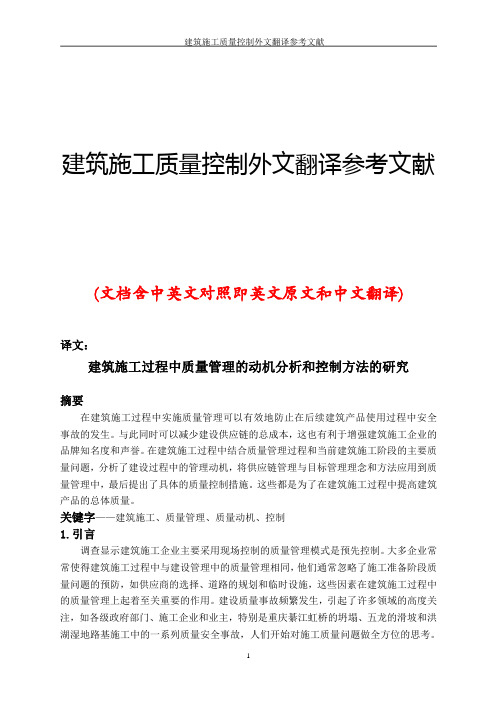
建筑施工质量控制外文翻译参考文献(文档含中英文对照即英文原文和中文翻译)译文:建筑施工过程中质量管理的动机分析和控制方法的研究摘要在建筑施工过程中实施质量管理可以有效地防止在后续建筑产品使用过程中安全事故的发生。
与此同时可以减少建设供应链的总成本,这也有利于增强建筑施工企业的品牌知名度和声誉。
在建筑施工过程中结合质量管理过程和当前建筑施工阶段的主要质量问题,分析了建设过程中的管理动机,将供应链管理与目标管理理念和方法应用到质量管理中,最后提出了具体的质量控制措施。
这些都是为了在建筑施工过程中提高建筑产品的总体质量。
关键字——建筑施工、质量管理、质量动机、控制1.引言调查显示建筑施工企业主要采用现场控制的质量管理模式是预先控制。
大多企业常常使得建筑施工过程中与建设管理中的质量管理相同,他们通常忽略了施工准备阶段质量问题的预防,如供应商的选择、道路的规划和临时设施,这些因素在建筑施工过程中的质量管理上起着至关重要的作用。
建设质量事故频繁发生,引起了许多领域的高度关注,如各级政府部门、施工企业和业主,特别是重庆綦江虹桥的坍塌、五龙的滑坡和洪湖湿地路基施工中的一系列质量安全事故,人们开始对施工质量问题做全方位的思考。
通过研究李秀峰总结归纳了造成工程的质量问题并引入项目质量控制分析方法,Low Sui Pheng 和Jasmine Ann Teo[2] 建立了施工中的质量管理框架来通过经验分析实现项目的质量控制,SangHyun Lee and others[3] 利用系统质量动态结构和变更管理模型的编程方法和控制方法,最终实现了大规模的并行设计和施工项目的管理和控制。
方唐分析了建设项目质量管理的整个过程和控制方法,她认为应该实现对影响建设单位质量的人、材料、机械、方法和环境的完全控制;吴天翔研究出管理因素是影响建设项目质量控制的重要因素,强调了施工过程中需要严格控制的各个方面和整体实现加强管理的需要。
为了解决建设施工过程中的建设质量问题,韩伟建立了一个建筑项目的分析和处理程序。
外文文献翻译——顾客满意度(附原文)
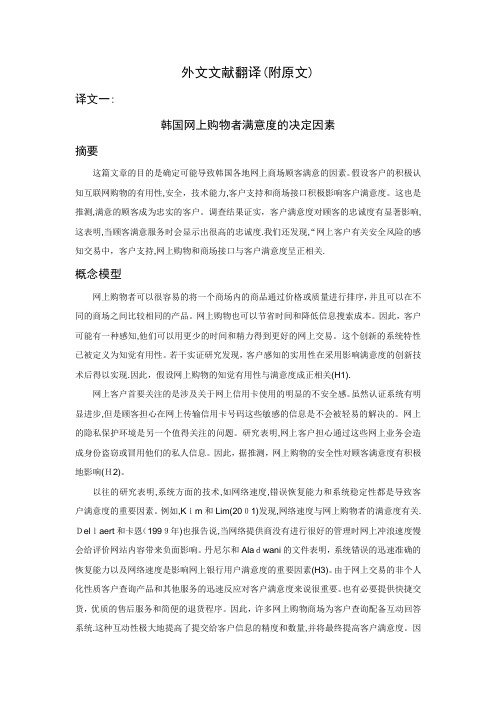
外文文献翻译(附原文)译文一:韩国网上购物者满意度的决定因素摘要这篇文章的目的是确定可能导致韩国各地网上商场顾客满意的因素。
假设客户的积极认知互联网购物的有用性,安全,技术能力,客户支持和商场接口积极影响客户满意度。
这也是推测,满意的顾客成为忠实的客户。
调查结果证实,客户满意度对顾客的忠诚度有显著影响,这表明,当顾客满意服务时会显示出很高的忠诚度.我们还发现,“网上客户有关安全风险的感知交易中,客户支持,网上购物和商场接口与客户满意度呈正相关.概念模型网上购物者可以很容易的将一个商场内的商品通过价格或质量进行排序,并且可以在不同的商场之间比较相同的产品。
网上购物也可以节省时间和降低信息搜索成本。
因此,客户可能有一种感知,他们可以用更少的时间和精力得到更好的网上交易。
这个创新的系统特性已被定义为知觉有用性。
若干实证研究发现,客户感知的实用性在采用影响满意度的创新技术后得以实现.因此,假设网上购物的知觉有用性与满意度成正相关(H1).网上客户首要关注的是涉及关于网上信用卡使用的明显的不安全感。
虽然认证系统有明显进步,但是顾客担心在网上传输信用卡号码这些敏感的信息是不会被轻易的解决的。
网上的隐私保护环境是另一个值得关注的问题。
研究表明,网上客户担心通过这些网上业务会造成身份盗窃或冒用他们的私人信息。
因此,据推测,网上购物的安全性对顾客满意度有积极地影响(H2)。
以往的研究表明,系统方面的技术,如网络速度,错误恢复能力和系统稳定性都是导致客户满意度的重要因素。
例如,Kim和Lim(2001)发现,网络速度与网上购物者的满意度有关.Dellaert和卡恩(1999年)也报告说,当网络提供商没有进行很好的管理时网上冲浪速度慢会给评价网站内容带来负面影响。
丹尼尔和Aladwani的文件表明,系统错误的迅速准确的恢复能力以及网络速度是影响网上银行用户满意度的重要因素(H3)。
由于网上交易的非个人化性质客户查询产品和其他服务的迅速反应对客户满意度来说很重要。
3D打印外文文献

机械工程学院毕业设计(外文翻译)题3D printer designintroductionWith the progress of the times, our standard of living is increasing, at the same time, the population is growing rapidly, we need more and more items to meet the conditions of material life. This certanly will cause our requirements for goods will be more and more high, fine workmanship, unique and non production items will be affected by the broad masses of people's favorite. Now, we have the advanced technology of 3D printing, and we can print all kinds of what we need and want through the 3D printer. 3D printing technology applications, it can be used in the medical industry, scientific research, product model, architectural design, manufacturing and food and so on, a wide range of prospects.3D printing technology, is based on a digital model file, the use of powdered metal or plastic and other materials can be bonded by layer by layer, the way to construct the object technology. 3D printer appeared in the 90's of last century, that is, the use of light curing and paper laminating technology, such as rapid prototyping. It is basically the same with ordinary printer working principle, printer equipped with liquid or powder and other printed materials ", and computer connection, through the computer control to print materials a superimposed layers. At last, the computer on the blueprint into the physical. Now this technology has been applied in many fields, people use it to make clothing, building models, cars, chocolate desserts, etc..1.1 research status of 3D printers at home and abroadResearch status of 1.1.1 foreign 3D printerAfter more than ten years of exploration and development, 3D printing technology has made considerable progress, at present, it has been able to achieve the fine resolution of 600dpi in the single layer thickness of 0.01mm. At present, the international advanced products can achieve the vertical rate of 25mm thickness per hour, and can realize the color of the 24 color printing.Currently, in the global 3D printer industry, the United States Systems 3D and Stratasys two companies to occupy the vast majority of the market share. In addition, in this field has a strong technical strength and characteristics of the enterprise, Systems 3D is the world's largest rapid prototyping equipment development company. In November 2011 acquired the first inventor of the 3D printing technology and the original patent owner Corporation Z, Systems 3D has laid a leading position in the field of 3D printing. Stratasys company in 2010 with the traditional printing industry giant Hewlett-Packard Co signed a OEM cooperation agreement, the production of 3D brand HP printer. Following the acquisition of Solidscape in May 2011, Stratasys in April 2012 with Israel's famous 3D printing system provider Objet announced the merger. At present, the international 3D printer manufacturing industry is in a rapid merger and integration process, the industry giants are accelerating the rise.Currently in developed countries in Europe and America, 3D printing technology has initially formed a successful business model. As in the field of consumer electronics, aerospace and automotive manufacturing, 3D printing technology can be a lower cost, higher efficiency of the production of small quantities of custom components, complete the complex and sophisticated modeling. In addition, the application of 3D printing technology is the field of personalized consumer goods industry. Such as quirky New York a creative consumer goods companies through the online collection of user design, 3D printing technology to made physical products and sales through the electronic market, a year can be launched 60 kinds of innovative products, the annual income reached $100 million.Research status of 3D printer in China 1.1.2Since 1990s, many colleges and universities have carried out the independent research and development of 3D printing technology. Tsinghua University in modern molding science theory, laminated object manufacturing, FDM technology has some advantages of scientific research; Huazhong University of science and technology in the laminated object manufacturing technology advantage, and has launched a series of HRP molding machine and molding materials [1]; Xi'an Jiaotong University independently developed a 3D printer nozzle, and the development of the light curing molding system and molding materials, molding precision reached 40.2mm; University of science and technology of China developed eight nozzle combination injection device, is expected to in micro manufacturing, the field of optoelectronic devices are applied. But overall, the domestic 3D printing technology research and development level is still a big gap compared with foreign countries.In recent years, domestic enterprises have realized the 3D printer machine production and sales, the common features of these companies is returned from overseas team established, on a smaller scale, product technology and foreign manufacturers of similar products compared is still in the low-end. At present, the domestic 3D printer in the print accuracy, print speed, print size and software support is still difficult to meet the needs of the business, the technical level to be further enhanced. In the area of services, the eastern developed cities of our country have been generally have enterprise application of imported 3D printing equipment to carry out commercial rapid prototyping services. Its range of services relates to mold making, sample making, aided design and restoration of cultural relics, such as multiple fields. Compared with the mainland, China's Hong Kong and Taiwan 3D printing technology introduced earlier, the application is more extensive, but the Hong Kong and Taiwan mainly focus on technology applications, rather than independent research and development.1.2 development trends of 3D printers3D 1.2.1 printing industry's future development prospectsAccording to the international rapid manufacturing industry authority report, "Report Wohlers 2011" published findings, the global 3D printing industry output value in the 1988 ~ 2010 years to maintain an average annual growth rate of 26.2%. The report is expected, the future of 3D printingindustry will continue to grow rapidly, by 2016, including equipment manufacturing and services, the total output value of the industry will reach $3 billion 100 million in 2020 will reach $2 [5 billion 200 million].But 3D printing technology to further expand its industrial application space, the current3D打印机设计引言随着时代的进步,我们的生活水平日渐提升,同时,人口也在急剧的增长,我们需要越来越多的物品来满足物质生活条件。
物流外文文献及翻译
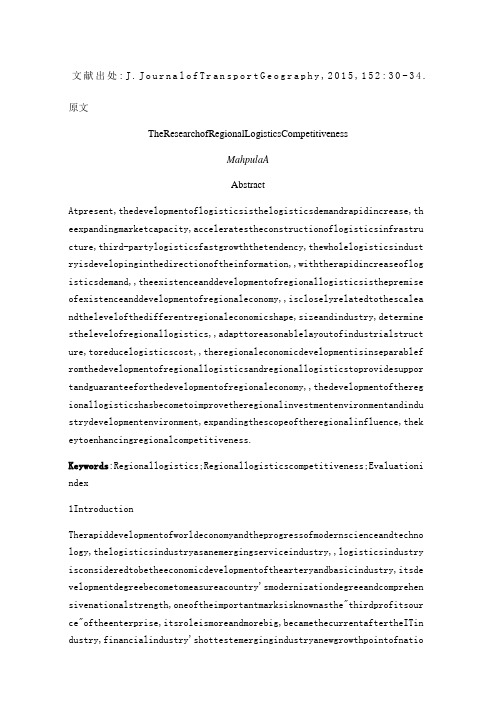
文献出处:J.J o u r n a l o f T r a n s p o r t G e o g r a p h y,2015,152:30-34.原文TheResearchofRegionalLogisticsCompetitivenessMahpulaAAbstractAtpresent,thedevelopmentoflogisticsisthelogisticsdemandrapidincrease,th eexpandingmarketcapacity,acceleratestheconstructionoflogisticsinfrastru cture,third-partylogisticsfastgrowththetendency,thewholelogisticsindust ryisdevelopinginthedirectionoftheinformation,,withtherapidincreaseoflog isticsdemand,,theexistenceanddevelopmentofregionallogisticsisthepremise ofexistenceanddevelopmentofregionaleconomy,,iscloselyrelatedtothescalea ndthelevelofthedifferentregionaleconomicshape,sizeandindustry,determine sthelevelofregionallogistics,,adapttoreasonablelayoutofindustrialstruct ure,toreducelogisticscost,,theregionaleconomicdevelopmentisinseparablef romthedevelopmentofregionallogisticsandregionallogisticstoprovidesuppor tandguaranteeforthedevelopmentofregionaleconomy,,thedevelopmentofthereg ionallogisticshasbecometoimprovetheregionalinvestmentenvironmentandindu strydevelopmentenvironment,expandingthescopeoftheregionalinfluence,thek eytoenhancingregionalcompetitiveness.Keywords:Regionallogistics;Regionallogisticscompetitiveness;Evaluationi ndex1IntroductionTherapiddevelopmentofworldeconomyandtheprogressofmodernscienceandtechno logy,thelogisticsindustryasanemergingserviceindustry,,logisticsindustry isconsideredtobetheeconomicdevelopmentofthearteryandbasicindustry,itsde velopmentdegreebecometomeasureacountry'smodernizationdegreeandcomprehen sivenationalstrength,oneoftheimportantmarksisknownasthe"thirdprofitsour ce"oftheenterprise,itsroleismoreandmorebig,becamethecurrentaftertheITin dustry,financialindustry'shottestemergingindustryanewgrowthpointofnationaleconomy,,istheimportantforceintheformationanddevelopmentofregionalec onomy,itistoimprovetheefficiencyandeconomicbenefitinthefieldofregionalc irculation,improvethecompetitiveabilityofregionalmarket,etc.,,however,t herearestillmanyproblems;,sincethereisnouniformstandard,,withthetwoindi catorstomeasurelogisticsscalehascertainscientific,butitcan',,theproport ionofdifferentresearchersusedifferent,rangingfromteenstotwentypercent,, thelogisticsindustry'seconomicstatisticaldatashortage,thereisnocomprehe nsivelogisticsdemandstatistics,whichmadeusqualitativeunderstandingofthe levelofunderstandingoflogistics.2LiteraturereviewAbouttheCoreCompetencetheory,CoreCompetenceCoreCompetenceoftheoriginali ntentionistheCoreskillsorCoreskills,thisconceptisin1990bytheAmericanstr ategicmanagementexpertsmade'sstrategicmanagementexpertshamer,referstoth eenterpriseorganizationofaccumulatingknowledge,especiallyabouthowtocoor dinatedifferentproductionskillsandintegrateavarietyoftechnicalknowledge ,andonthebasisofadvantageoverothercompetitorsuniqueability,namelyCoreCo mpetenceisbuiltonthebasisofenterpriseCoreresources,istheenterpriseintel ligence,technology,products,management,:theabilitytheoryrepresentedbyRo ssbyandChristie'sschool;Schoolrepresentedbyporter'stheoryofmarketstruct ure;RepresentedbyWernerPhilandPenrose',theabilitytointegrated,uniquenes s,extensibilityandinherentcharacteristics.Relatedtheory,thestudyofregionallogistics,thelogisticsresearchofEuropea ndtheUnitedStates,Japanandotherdevelopedcountries,focusontheenterprisel evel,,,theregionalinternationallogisticsfieldofresearchmainlyincludesth efollowingaspects:1,,morefortheglobalnetworkofsupplychainfacilitylocati onpositioning,andcoordinatethefactorymoresupport,,thecommonlyusedmethod sincludemathematicalanalyticalmethod,systemsimulationmethodandheuristic methods,;Mixedintegerprogrammingsolvetheproblemofsiteselectionoflogisti cscenterandlogisticsplanning,etc.2fromtheperspectiveofurbaneconomyandth eenvironment,,usingadynamictrafficsimulationmodel,quantitativeresearche conomicgrowth,thetransportdemand,aswellastherelatedroadcongestionandenv ironmentalpollution.3fromthepointofviewofthecitygovernment,Flow,thethirdpartylogisticsenterprise,storageandtransportationenterpris e,,'sabilitytoprovidelogisticsservicesandmeetcustomerdemand,embodiesthe subjectoflogisticsoperationlevel,mainlyincludingtheenterprisecompetitio nability,profitabilityandperformancelevel,reflectacertainperiodoflogist icsenterprisesintheareaoftheoveralllevelofdevelopment,isthekeyfactorfor theformationofregionallogisticscompetitiveness.,,thedevelopmentlevelofinformationistheoneimportantfactorfortheformatio nofregionallogisticscompetitivenesslevel.Macroenvironmentreferstothelogisticsindustrydevelopmentoflogisticsindus trydevelopmentplanning,landusepolicy,taxpolicy,marketaccesspolicy,talen ttraining,suchasthesoftenvironment,affectingthedevelopmentoflogisticsin dustryreflectstheexternalenvironmentforthedevelopmentofthelogisticsindu strytoprovidefavorableconditionsandtheenvironmentsupport.译文区域物流竞争力研究作者MahpulaA摘要当前,物流的发展正呈现出物流需求快速上升、市场容量不断扩大、物流基础设施建设加速、第三方物流快速成长的趋势,整个物流产业正朝着信息化、全球化和专业化的方向发展;同时,随着物流需求的快速增加,区域物流的发展更加迅猛;区域物流是区域经济的重要组成部分,区域物流的存在和发展是以区域经济的存在和发展为前提的,没有区域经济也就没有区域物流;区域物流与区域经济发展的水平、规模密切相关,不同区域经济的水平、规模和产业形态,决定了区域物流的水平、规模和结构形态;区域经济一体化能使区域内和区域间的物流趋向合理,适应产业结构的合理布局,从而降低物流成本,促进区域物流发展;反之,区域经济的发展也离不开区域物流的发展,区域物流为区域经济的发展提供支撑与保障,区域物流的发展将带动和促进区域经济的进一步发展;因此,区域物流的发展己成为改善区域投资环境和产业发展环境、扩大区域影响范围、提升区域竞争力的关键;关键词:区域物流,区域物流竞争力,评价指标1引言世界经济的快速发展和现代科学技术的进步,物流产业作为一个新兴的服务性产业,正在全球范围内迅速发展;在国际上,物流产业被认为是经济发展的动脉和基础产业,其发展程度成为衡量一国现代化程度和综合国力的重要标志之一,被誉为企业的“第三利润源泉”,其发挥的作用越来越大,成为了继IT业、金融业之后的当前最热门的新兴产业和国民经济新的增长点,引起了社会的普遍重视;区域物流是区域经济的重要构成要素,是区域经济形成与发展的重要力量,它对提高区域流通领域的效率和经济效益,提高区域市场的竞争能力等,发挥着积极的能动作用;然而,现代物流快速发展的背后仍然存在较多的问题,其中物流竞争力水平低于物流发展水平显得尤为突出;选择物流竞争力发展水平评价指标时,由于没有统一的标准,只能利用货运量或货运周转量来衡量物流规模;运输是物流过程中实现货物空间位移的中心环节,用这两个指标来衡量物流规模有一定的科学性,但不能真实反映地区物流的全貌;估计物流需求量时,通常的做法是根据GDP和社会消费品零售总额等国民经济核算指标;这仅仅是宏观层次上的一种简单估算,不同的研究人员采用的比例不同,从百分之十几到百分之二十不等,所得结果存在较大差异,给理论分析带来了较大的困难;同时,有关物流产业的经济统计资料极度缺乏,也没有全面的物流需求统计数据,这使我们对物流的理解始终处于定性的认识水平上;2文献综述关于核心竞争力理论,核心竞争力Core关于区域物流的相关理论研究,物流发达的欧美、日本等国研究,侧重于企业层面,即致力于提供企业优化策略;而区域层面的物流系统及竞争力研究,则涉及不多;根据文献查阅,国际上区域性物流领域研究,主要包括以下几个方面:1从跨国公司角度研究全球性物流资源配置和协调问题;具体包括物流基础设施、市场竞争机制及物流供应链运行等问题;此类研究多利用运筹学等数量化技术工具,为供应链的全球网络设施选址定位、多工厂协调、战略配送体系设计等问题提供支持;这是企业层面物流优化研究的扩展,常用方法包括数学解析法、系统仿真法和启发式方法等;如位分法和图解法解决一元网点的布局问题;混合整数规划解决物流中心的选址以及物流规划问题等;2从城市经济和环境角度,研究城市交通网络的设置问题;例如Tanjguchietal从城市层面,利用交通仿真动力学模型,定量研究经济增长、运输需求,以及道路拥挤和环境污染的相互关联;3从城市政府角度,研究其在宏观物流发展中承担的角色和效用;例如和Senblatt,研究了全球化供应链管理中设施融资、交通以及地区交易规则、企业税费法律中的政府补贴等全球生产和配送网络主要因素的效用等;3区域物流相关理论概述区域物流的定义学术界对区域物流的定义尚未统一,一个比较认可的观点是,区域物流是在一定的区域地理环境中,以大中型城市为中心,以区域经济规模和范围为基础,结合物流的有效服务范围,将区域内外的各类物品从供应地向接受地进行的有效实体流动;是将运输、仓储、装卸搬运、配送、包装、流通加工、信息处理等物流活动集成,以服务于本区域经济发展的综合体系;它要求集成的、一体化的物流管理,即以满足用户需要为目的,对物品、服务及相关信息从供应地向接受地的有效率流动进行计划、执行和控制的活动,是物资流、信息流及资金流的有机统一体;区域物流主体、客体和载体的关系区域物流结构具有多层次、多维度的特点,其基本要素包括物流主体、物流客体和物流载体,而基本要素又有其各自完整的结构体系,每一要素都表现出不同的功能,从而形成区域物流的整体功能;区域物流主体是直接参与或专门从事区域物流活动的经济组织,包括货主物流企业、第三方物流企业、储运企业等;物流主体是供应链物流渠道起点和终点的联接者,在整个区域物流活动过程中起着主导和决定性的作用;物流主体要素的集成是现代物流的本质特点;因此,集物流各要素为一体的物流主体,对于物流业发展具有决定性作用;与区域经济产业积聚相类似,区域物流也强调物流主体积聚,物流主体在空间上的积聚有利于促进物流活动的规模化、集约化、体化发展,这也是区域物流园区、物流中心、配送中心形成的客观基础,而区域物流园区、物流中心、配送中心决定了整个区域物流系统的空间结构;区域物流与区域经济的关系区域物流是区域经济的重要组成部分,区域物流的存在和发展是以区域经济的存在和发展为前提的,没有区域经济也就没有区域物流;区域物流与区域经济发展的水平、规模密切相关,不同区域经济的水平、规模和产业形态,决定了区域物流的水平、规模和结构形态;物流总是伴随着商流而生,区域经济越发达,制造及商贸越活跃,作为服务行业的物流业就会有良好的客户群和市场基础,大规模发展的可能性越大;反之,区域经济的发展也离不开区域物流的发展,区域物流为区域经济的发展提供支撑与保障,区域物流的发展将带动和促进区域经济的进一步发展;由此可见,区域物流与区域经济是相互依存的统一体;区域经济是区域物流发展的前提和基础,是拉动区域物流发展的主导力量;区域物流是区域经济的重要组成部分,是区域经济的支撑系统,为区域经济服务;区域物流的发展目标和战略必须服从并服务于区域经济发展的目标和战略;4区域物流竞争力区域物流竞争力是指某空间范围内一般以行政区域为边界,也可跨区域,物流产业所具有的区别于其它区域的资源察赋优势、物流企业能力、政府政策支持和产业创新能力,最终体现为通过区域内部的良性竞争将以上各种资源、能力有效整合而形成的具有互补性、整合性的能力体系,反映了各区域在物流活动中相比较的竞争能力,体现了区域物流服务能力的大小和物流业发展水平的高低;区域物流的竞争力主要由六项基本要素共同构成:社会经济发展水平、物流需求规模、物流供给状况、物流企业发展水平、信息发展水平、物流业发展宏观环境;社会经济发展水平社会经济发展水平综合反映了区域物流竞争力水平的社会经济基础,是区域物流竞争力发展的保障,为区域物流的可持续发展提供支撑,也从另一侧面反映了区域物流竞争力发展的潜力与动力;物流需求规模物流需求规模主要指物流服务的生产、消费、流通等领域的数量和规模,在一定程度上受当地资源条件的限制,它综合反映了一个地区对物流服务的需求程度和规模:物流需求规模的大小,决定了物流市场容量的大小,是区域物流产业存在和发展的前提与基础;物流供给状况物流供给状况指为物流业发展所提供的物流基础设施、各种物流技术装备、从事物流服务的企业及相应的从业人员等的数量和规模以及地区的交通能力状况,综合反映了区域物流的供给能力和服务水平,体现了对物流业发展的促进作用和满足程度,是区域物流竞争力形成和发展的主要因素;物流企业发展水平物流企业发展水平综合反映了区域内物流主体提供物流服务及满足客户需求的能力大小,体现了物流主体的运作水平,主要包括企业的竞争能力、盈利能力及绩效水平,反映了一定时期区域内物流企业的总体发展水平,是区域物流竞争力形成的关键因素;信息发展水平信息发展水平主要是指区域的信息化程度及信息技术水平的高低;物流是依据信息来流动的,物流的整个过程已越来越依赖于对信息的获取;许多物流企业已把建立自身的信息管理系统作为发展其核心竞争力的关键,可见信息的发展水平是区域物流竞争力水平形成的一个重要因素;物流业发展宏观环境物流业发展宏观环境主要指物流产业发展规划、土地利用政策、税收政策、市场准入政策、人才培养政策等影响物流业发展的软环境,体现了外界环境为物流业发展所提供的有利条件和环境支持;。
毕业论文外文文献翻译We-need-strategic-cost-management我们需要战略成本管理
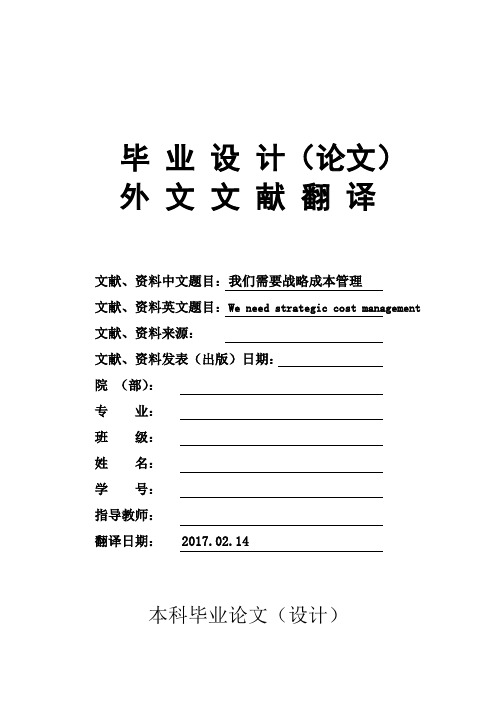
毕业设计(论文)外文文献翻译文献、资料中文题目:我们需要战略成本管理文献、资料英文题目:We need strategic cost management 文献、资料来源:文献、资料发表(出版)日期:院(部):专业:班级:姓名:学号:指导教师:翻译日期: 2017.02.14本科毕业论文(设计)外文翻译原文:We need strategic cost managementWe need strategic cost management? As noted earlier, the global financial crisis continues to wantonly slightly, off-season already unsolicited, but also to a year was bad, but even worse this year, Xi. Improve efficiency, reduce costs, many companies have become one of the ultimate weapon. Consequently, from Europe to the Americas, from global to domestic, sounded a dismissal, caused many large and small vibration. Various enterprises began Wujin their own property, to control expenditure, lowering of standards, so these are all related to the cost of this topic.In fact, the companies cut costs, all costs should not be without identification, "indiscriminate white uniform." If a business manager to every expenditure appears to cut off the excess, it is likely this weakened the competitiveness of enterprises and thus affects the business, results of more harm than good. Therefore, managers should be the perspective of corporate strategy to control costs and avoid damage to the value of those core elements of the decision. Consequently, cost-plus strategy, it leads to strategic cost management topics.He suggested approach for dedicating resources to supplier cost management may seem cost prohibitive. However, the organizations studied unanimously agree that they receive extremely high returns on their investments in supplier cost management efforts. The money spent on supplier cost management efforts. The money spent on supplier should-cost analysis, supplier development, and other tools and approaches pays for itself many times over in terms of reducing costs and bottom-line prices paid to suppliers. for large fortune 500 companies, successful strategic cost management may mean the addition of dedicated personnel to focus on supplier cost management. for smaller organizations which might not have as great an on-going need, or as great an asset base.So, what is strategic cost management? Strategy can be defined as the establishment of their fundamental long-term goals and to achieve the goals to take the necessary action planning and resource allocation, is to guide the overall plans and strategies. The so-called strategic cost management from a strategic perspective to study the formation and control costs. In established under the principle of corporate strategy, in terms of cost management for the strategic choice and design, it will lead to the final delivery of business products and services to lower costs, not every part of Shang Du Zhuiqiu lowest cost. Includes two levels of content: one from a cost perspective, the selection and optimization of business strategy; Second, the implementation of cost control strategies. Strategic cost management thinking on strategic cost management theoretical framework of the general and summary, which determines the strategic cost management theory and methodology to start the basic ideas.In the background of the crisis under the cost-cutting, more Xuyao follow strategic cost management thinking, to have a choice cut, not important link in the conduct of large Ke Yi drastic cuts; and the related core competitive Li's Guanjianyaosu, but not rule out the possibility of expanding into so targeted, there are tight with loose, smart, cost-cutting, a square is not only lower costs, but also without prejudice to the company health and even enhance the core competitiveness of the ideal choice.The basic tools of strategic cost management cost management strategy has three elements: value chain analysis, strategic positioning analysis and cost driver analysis. They also analyzed in the framework of strategic management and cost factors closely related to the three basic analysis tools.(A) of the value chain analysis of each end product from initial raw materials into the hands until it reaches the final consumer, intermediate to go through numerous interrelated operating procedures, these operating procedures is both a product of the production process, but it is also a value formation and value-added process to form the value chain (Value-chain). Value chain analysis can be divided into industry specific value chain analysis, value chain analysis and value chainanalysis of competitors. Through the analysis of the industry value chain, we understand the position of enterprises in industry and trade situation and prospects; through its own analysis of the value chain, eliminate non-value-added factors, we can not affect the decline in cost competitiveness of the premise; by value chain analysis of the competitors, you can know ourselves and insight into the situation, and the resulting business cost management strategies.(B) the strategic positioning analysis. Strategic positioning means of selecting the means of competition, and compete with rivals. Enterprises should first of all the internal and external environment in which their own detailed investigation of; then Queding enterprises are entering the Xing Ye Ying, based on the market by Shige Yijisuoxu Kaifa of products; finally determine to what strategy to ensure that enterprises in the selected industry, market and product stand firm in the defeat, to obtain profits above the industry average. To illustrate, such as cost leadership strategy, which is all a strategy most clearly? Under the guidance in this strategy, Enterprise's goal is to become of its properties to low-cost, Sheng Chan (services) Chang Shang, that is, offerings (or service) features, little quality difference in the conditions, cutting costs gain a competitive edge. If enterprises can create and maintain a comprehensive cost leader. That is as long as the price control in the industry average or close to the average level, we can obtain better than average results of operations. With opponents equal to or lower price, the cost leader in low-cost advantage will translate into higher earnings. The difference between strategic requirements of enterprises leading the extensive attention on some aspects of customers in unique within the industry, or the difference in cost is difficult to further expand the circumstances, the production of more powerful than the competition, better quality, service and better products to show the difference between operating . Of course, this difference should the buyer want or willing to accept. If a leader can be different, you can get the price premium paid, or in a certain price to sell more products, or cyclical, seasonal market access, such as shrinking the buyer loyalty during the corresponding benefits. Requirements between the logic of a leading strategic business choices that are conducive to competition and make theirown unique nature of the business, focusing on innovation. In addition to these, other common gathering strategies targeted strategic positioning, life cycle strategy and integration strategy and so on.(C) Cost Driver Analysis. Cost drivers is the driving force caused by production costs and causes of occurrence. Strategic cost driver is mainly a strategic cost management perspective, research on the company's cost structure and cost behavior of long-term impact of cost drivers. Theory of competitive strategy to create a business management scientist Michael * Porter will be divided into ten areas of these factors, namely economies of scale, learning curve, production capacity, use the form, contact, mutual relations, joint, select the time, independent policy, geography factor in location and form of government. Some scholars further strategic structural cost drivers and cost driver is divided into two types of implementation of cost drivers. The case of structural cost control, such as Southwest Airlines in response to competition, positioning its service route rather than the full route in a particular short-distance flights to avoid engaging in large-scale airport operations, to cancel dinner, reservation and other special services, and the establishment of automatic ticketing system and other measures to reduce costs. The results of many of its daily flights and low issue price attracted a lot of short-range travelers, lead to the establishment of the final cost.Source:Shank. J.K and V. Govindarajan,1993.”We need strategic cost management” . Harvard business review. August.pp.112-135.译文:我们需要战略成本管理我们需要战略成本管理?就像之前提到的,全球的金融危机继续,金融危机的时段过去后,提高效率,降低成本,已成为许多公司的最终武器。
外文文献-关于Eclipse基金会和Java(可编辑)(可编辑)

外文文献-关于Eclipse基金会和Java毕业设计说明书英文文献及中文翻译关于Eclipse基金会和JavaEclipse和Eclipse基金会是什么?Eclipse是一个社会谁愿意对商业友好的开源软件合作的个人和组织。
其项目主要集中在建立一个开放的开发平台,用于构建,部署和管理软件的整个生命周期包括可扩展的框架,工具和运行时。
Eclipse基金会是一个不以营利为目的,支持会员公司举办的Eclipse项目,有助于培养一个开源社区和生态系统的互补的产品和服务。
Eclipse项目最初是由IBM创建于2001年11月,由软件供应商组成的财团的支持。
Eclipse基金会创建于2004年1月作为一个独立的不以营利为目的的公司,作为Eclipse社区的管家。
创建独立的不以营利为目的的公司,让各地建立了Eclipse的一个厂商中立和开放的,透明的社会。
如今,Eclipse社区由截面软件产业的个人和组织。
Eclipse基金会是由来自我们会员的年费,并受船上董事。
战略开发和战略消费者持有本次董事会席位,选出的代表加入提供商和开放源码的提交。
该基金会雇用一个全职专业的工作人员,向社会提供服务,但不采用开放原始码开发人员,称为委托者,这实际上在Eclipse项目工作。
通常采用的Eclipse提交组织或志愿服务的独立软件开发商,他们的工作时间上的一个开源项目。
在一般情况下,Eclipse基金会提供四种服务Eclipse社区:1)IT基础设施,2)IP管理,3)发展过程中,和4)生态系统的发展。
全职员工都与上述各领域和更大的Eclipse社区工作,以协助满足利益相关者的需求。
IT基础设施Eclipse基金会管理的IT基础设施,包括Eclipse开源社区的Git代码库,Bugzilla的数据库,以发展为导向的邮件列表,论坛,下载网站和网站。
提交者开发Eclipse的技术和消费者使用技术基础设施的设计提供可靠和可扩展的服务。
食品安全外文文献
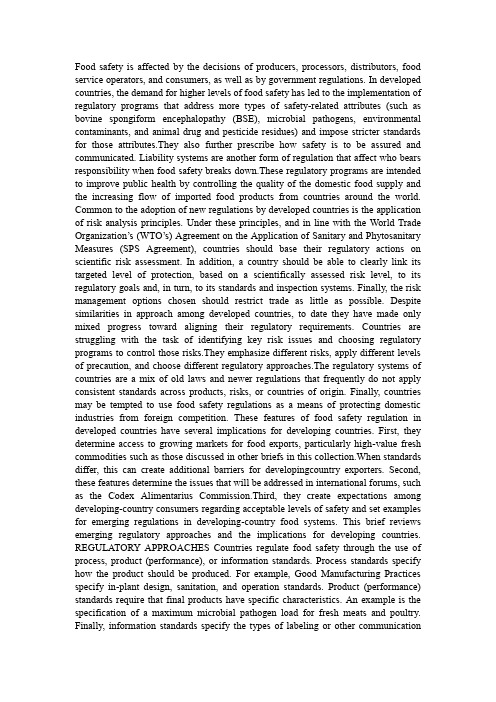
Food safety is affected by the decisions of producers, processors, distributors, food service operators, and consumers, as well as by government regulations. In developed countries, the demand for higher levels of food safety has led to the implementation of regulatory programs that address more types of safety-related attributes (such as bovine spongiform encephalopathy (BSE), microbial pathogens, environmental contaminants, and animal drug and pesticide residues) and impose stricter standards for those attributes.They also further prescribe how safety is to be assured and communicated. Liability systems are another form of regulation that affect who bears responsibility when food safety breaks down.These regulatory programs are intended to improve public health by controlling the quality of the domestic food supply and the increasing flow of imported food products from countries around the world. Common to the adoption of new regulations by developed countries is the application of risk analysis principles. Under these principles, and in line with the World Trade Organization’s (WTO’s) Agreement on the Application of Sanitary and Phytosanitary Measures (SPS Agreement), countries should base their regulatory actions on scientific risk assessment. In addition, a country should be able to clearly link its targeted level of protection, based on a scientifically assessed risk level, to its regulatory goals and, in turn, to its standards and inspection systems. Finally, the risk management options chosen should restrict trade as little as possible. Despite similarities in approach among developed countries, to date they have made only mixed progress toward aligning their regulatory requirements. Countries are struggling with the task of identifying key risk issues and choosing regulatory programs to control those risks.They emphasize different risks, apply different levels of precaution, and choose different regulatory approaches.The regulatory systems of countries are a mix of old laws and newer regulations that frequently do not apply consistent standards across products, risks, or countries of origin. Finally, countries may be tempted to use food safety regulations as a means of protecting domestic industries from foreign competition. These features of food safety regulation in developed countries have several implications for developing countries. First, they determine access to growing markets for food exports, particularly high-value fresh commodities such as those discussed in other briefs in this collection.When standards differ, this can create additional barriers for developingcountry exporters. Second, these features determine the issues that will be addressed in international forums, such as the Codex Alimentarius Commission.Third, they create expectations among developing-country consumers regarding acceptable levels of safety and set examples for emerging regulations in developing-country food systems. This brief reviews emerging regulatory approaches and the implications for developing countries. REGULATORY APPROACHES Countries regulate food safety through the use of process, product (performance), or information standards. Process standards specify how the product should be produced. For example, Good Manufacturing Practices specify in-plant design, sanitation, and operation standards. Product (performance) standards require that final products have specific characteristics. An example is the specification of a maximum microbial pathogen load for fresh meats and poultry. Finally, information standards specify the types of labeling or other communicationthat must accompany products. While these categories provide a neat breakdown, in practice most countries use a combination of approaches to regulate any particular food safety risk. For example, specifications for acceptable in-plant operations may be backed up with final product testing to monitor and verify the success of safety assurance programs. Labeling that instructs final consumers on proper food handling techniques may further back up these systems. MAJOR REGULATORY TRENDS IN DEVELOPED COUNTRIES • Stronger public health and consumer welfare emphasis in decisions by regulatory agencies. The increasing use of the risk analysis framework for regulatory decision-making focuses attention on the effective control of public health risks as the ultimate goal of regulations, rather than intermediate steps such as assuring that accepted practices are used in production.This in turn leads to a focus on the food supply chain, on identifying where hazards are introduced into it, and on determining where those hazards can be controlled most cost effectively in the chain.This approach is referred to as “farm to table” or “farm to fork” analysis.When the supply chain extends across international borders, risk analysis may encompass farm or processing practices in developing countries. • Adoption of more stringent safety standards, with a broader scope of standards. Food safety standards are becoming more stringent in developed countries on two fronts. First, in many cases food safety attributes that were previously regulated are being held to more precise and stringent standards. For example, rather than assuring meat product safety simply through process standards, those products may be required to meet specific pathogen load standards for E. coli or Salmonella. Similarly, tolerances for aflatoxin may be lowered as more information and better testing become readily available. Second, the scope of standards is broadening, as new risks become known. For example, the European Union, the United States, and other countries have instituted strict feeding restrictions to avoid the spread of BSE in cattle. In addition, the European Union has recently established a regulatory program to control human exposure to dioxins through the food supply.These evolving standards create continuing challenges for producers and regulatory agencies in exporting countries. • Adoption of the HACCP approach to assuring safety. During the 1990s, developed countries made a strong shift toward requiring the Hazard Analysis Critical Control Point (HACCP) approach to assuring food safety. Under HACCP, companies are responsible for analyzing how hazards such as food-borne pathogens may enter the product, establishing effective control points for those hazards, and monitoring and updating the system to assure high levels of food safety.These HACCP systems are usually predicated on the processing plant having an adequate system of sanitary operating procedures already in place. HACCP does not prescribe specific actions to be taken in a plant: the company chooses its methods for controlling hazards. HACCP systems make clear that the central responsibility for assuring safety belongs to a company; the regulator’s job is often shifted from one of direct inspection to providing oversight for the company’s operation of its HACCP plan. Since HACCP is primarily a process standard for company-level activity, inspection to assure compliance is challenging for imported products coming from plants in other countries. Some countries, such as those in the European Union, have mandated HACCP for all levels of the food supplychain, while others such as the United States have mandated it for specific sectors (meat slaughter and processing, for example). • Adoption of hybrid regulatory systems. Mandatory HACCP may be combined with performance standards for finished products.The performance standards (a minimum incidence of Salmonella in finished products, for example) provide a check on whether the HACCP plan is performing adequately.The increased use of performance standards has been facilitated by the development of more accurate and speedier testing procedures, particularly for pathogens. Eventually such tests may make it easier for exporters to demonstrate and verify a particular level of safety.食品安全受生产者、加工者、经销商、餐饮服务经营者决策的影响,也受到消费者和政府法规的影响。
- 1、下载文档前请自行甄别文档内容的完整性,平台不提供额外的编辑、内容补充、找答案等附加服务。
- 2、"仅部分预览"的文档,不可在线预览部分如存在完整性等问题,可反馈申请退款(可完整预览的文档不适用该条件!)。
- 3、如文档侵犯您的权益,请联系客服反馈,我们会尽快为您处理(人工客服工作时间:9:00-18:30)。
矿产资源开发利用方案编写内容要求及审查大纲
矿产资源开发利用方案编写内容要求及《矿产资源开发利用方案》审查大纲一、概述
㈠矿区位置、隶属关系和企业性质。
如为改扩建矿山, 应说明矿山现状、
特点及存在的主要问题。
㈡编制依据
(1简述项目前期工作进展情况及与有关方面对项目的意向性协议情况。
(2 列出开发利用方案编制所依据的主要基础性资料的名称。
如经储量管理部门认定的矿区地质勘探报告、选矿试验报告、加工利用试验报告、工程地质初评资料、矿区水文资料和供水资料等。
对改、扩建矿山应有生产实际资料, 如矿山总平面现状图、矿床开拓系统图、采场现状图和主要采选设备清单等。
二、矿产品需求现状和预测
㈠该矿产在国内需求情况和市场供应情况
1、矿产品现状及加工利用趋向。
2、国内近、远期的需求量及主要销向预测。
㈡产品价格分析
1、国内矿产品价格现状。
2、矿产品价格稳定性及变化趋势。
三、矿产资源概况
㈠矿区总体概况
1、矿区总体规划情况。
2、矿区矿产资源概况。
3、该设计与矿区总体开发的关系。
㈡该设计项目的资源概况
1、矿床地质及构造特征。
2、矿床开采技术条件及水文地质条件。
